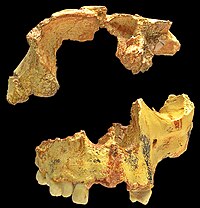Homo antecessor
Homo antecessor is an extinct human species dating from 1.2 million to 770,000 years ago.[1] It is is one of the earliest known human varieties in Europe.[2]
| Homo antecessor Temporal range: Early Pleistocene
| |
|---|---|

| |
| Scientific classification | |
| Kingdom: | |
| Phylum: | |
| Class: | |
| Order: | |
| Superfamily: | |
| Family: | |
| Genus: | |
| Species: | H. antecessor
|
| Binomial name | |
| †Homo antecessor Bermudez de Castro et al., 1997
| |
The best-preserved fossil is a maxilla (upper jaw bone). It belonged to a 10-year-old individual found in Atapuerca, Spain. There were numerous examples of cuts on bones. The flesh had been cut from the bones. Maybe H. antecessor could have been cannibals.
H. antecessor may have been broad-chested and rather heavy, much like Neanderthals. Its limbs were proportionally long, which is a trait more frequent in tropical populations. The kneecaps are thin and have poorly developed tendon attachments. The feet indicate H. antecessor walked differently from modern humans.
H. antecessor usually made simple pebble and flake stone tools out of quartz and chert, but they also used other materials. This industry has some similarities with the more complex Acheulean. Acheulean is found in African and later European sites. Groups may have sent hunting parties to kill deer in their savannah and mixed woodland environment. As mentioned above, many of the H. antecessor specimens were cannibalised, perhaps as a cultural practice. There is no evidence they were using fire, and they only lived in Iberia during warm periods, presumably retreating to the South coast otherwise.

References change
- ↑ Bermudez de Castro J.M; Arsuaga J.L; Carbonell E; Rosas A; Martinez I. & Mosquera M. 1997. A hominid from the Lower Pleistocene of Atapuerca, Spain: possible ancestor to Neandertals and modern humans. Science. 276 (5317): 1392–1395. doi:10.1126/science.276.5317.1392. PMID 9162001. S2CID 31088294
- ↑ Campaña I; Pérez-González A; Benito-Calvo A; Rosell J; Blasco R; de Castro J.M.B; Carbonell E; & Arsuaga J.L. 2016. New interpretation of the Gran Dolina-TD6 bearing Homo antecessor deposits through sedimentological analysis. Scientific Reports. 6 (34799): 34799. Bibcode:2016NatSR...634799C. doi:10.1038/srep34799. PMC 5054435. PMID 27713562.
Related pages change